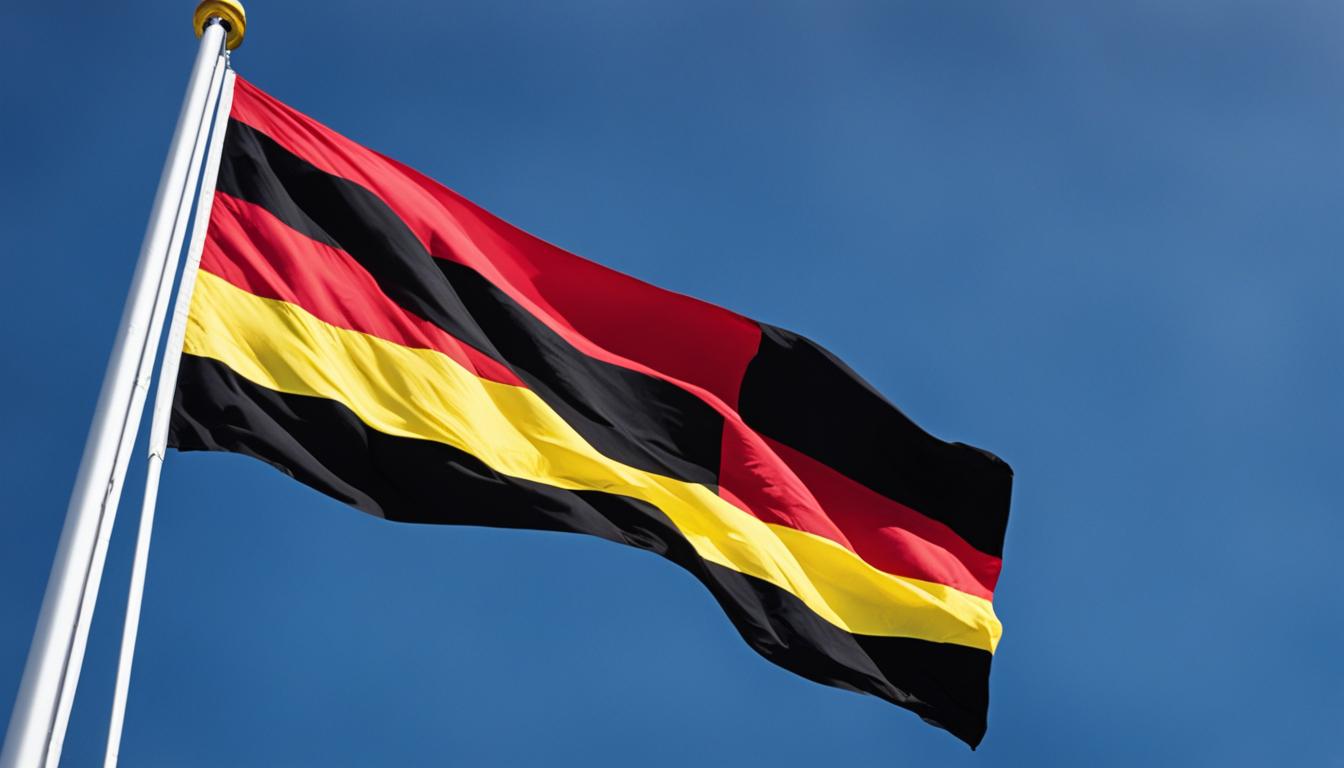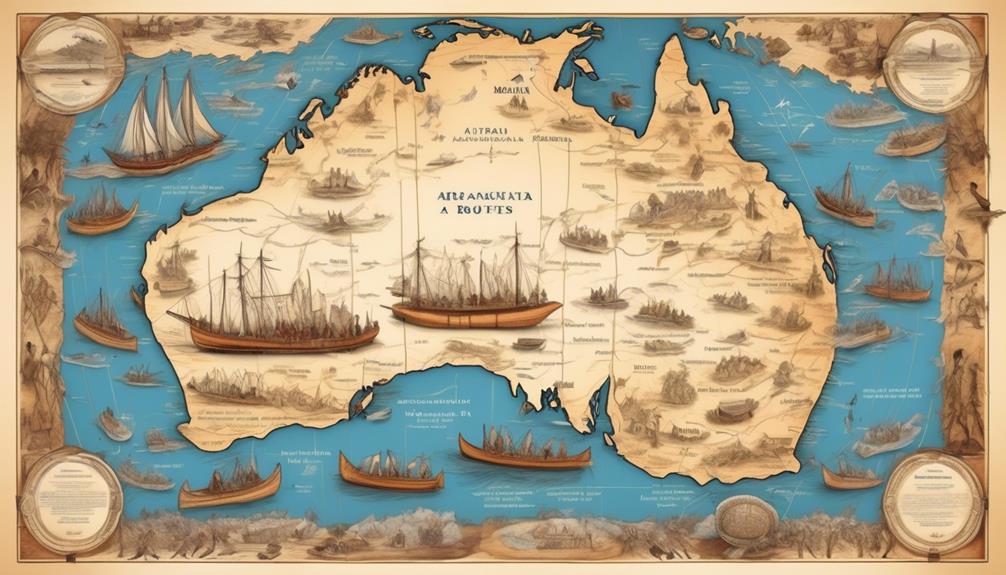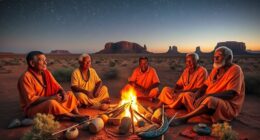Welcome to our in-depth guide focused on the Aboriginal flag, a prominent symbol representing the heritage, identity, and ongoing struggles of Indigenous Australians. Through this thorough examination, we will explore the meaning, historical background, importance, and symbolism of this iconic flag, which holds deep cultural and political significance in Australia.
Key Takeaways:
- The Aboriginal flag was designed by Harold Thomas, a Luritja man from central Australia, in 1970.
- The flag consists of a horizontal rectangle divided into equal halves of black (representing Aboriginal people) and red (representing the earth and spiritual connection to the land).
- In the center of the flag, there is a yellow circle symbolizing the sun.
- The Aboriginal flag was first raised on July 9, 1971, and in 1995, it was recognized by the Australian Government as an official ‘Flag of Australia’.
- Its design and colors hold deep symbolism for Indigenous Australians, reflecting their identity, heritage, and spirituality.
The Design and Symbolism of the Aboriginal Flag
The design of the Aboriginal flag is a beautiful representation of Indigenous culture and heritage.
Harold Thomas, a Luritja man from central Australia, designed the flag in 1970. Its simplicity speaks volumes and has made it an iconic symbol of Aboriginal pride.
The flag’s design consists of three significant elements:
- Black: This color represents Aboriginal people, their history, and their ongoing struggles. It serves as a powerful reminder of the strength and resilience of Indigenous Australians.
- Red: Symbolizing the earth and spiritual connection to the land, the red in the flag pays homage to the deep-rooted relationship Indigenous Australians have with their ancestral lands. It reflects their profound spiritual connection and custodianship of the land.
- Yellow: The yellow circle in the center of the flag represents the sun, a vital source of life and energy. It symbolizes the ongoing presence and significance of Indigenous cultures throughout Australia.
Together, these colors convey the story of Indigenous Australians, their identity, heritage, and spirituality. The design of the Aboriginal flag is a visual testament to the rich cultural tapestry and connection to the land that Indigenous communities hold dear.
The flag’s distinct design has been widely embraced and recognized, representing Aboriginal Australia across various mediums and platforms.
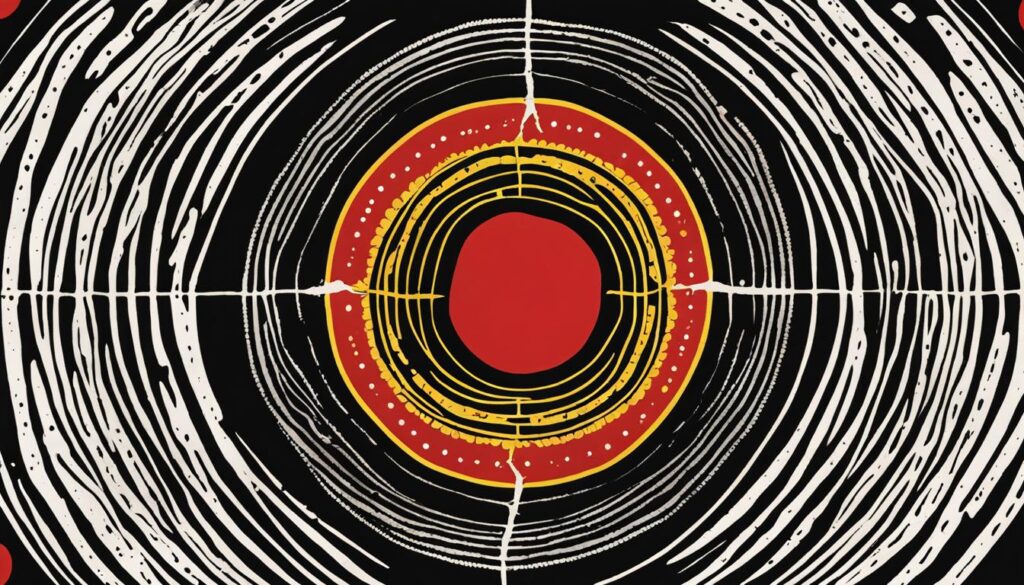
The simplicity and deep symbolism of the Aboriginal flag have made it a potent symbol of Aboriginal pride, unity, and resilience. It serves as a visual representation of the ongoing struggles, achievements, and culture of Indigenous Australians.
The History of the Aboriginal Flag
The Aboriginal flag has a rich history that encompasses the struggles, resilience, and aspirations of Indigenous Australians. It was first flown on July 9, 1971, during a land rights rally in Adelaide, South Australia, as part of the National Aborigines Day celebrations. This historic moment marked the flag’s emergence as a powerful symbol of Indigenous Australia’s fight for rights and recognition.
Designed by Harold Thomas, a Luritja man from central Australia, the Aboriginal flag embodies the deep cultural and political significance of Indigenous identity. The flag’s design features a horizontal rectangle divided equally into halves of black and red, with a vibrant yellow circle in the center.
The black represents Aboriginal people, symbolizing their resilience, strength, and pride. The red embodies the connection to the land, expressing the spiritual and cultural significance of the earth. The yellow circle represents the sun, signifying life, energy, and the ongoing presence of Indigenous cultures.
Following its inception, the Aboriginal flag quickly gained recognition and acceptance among Indigenous Australians and beyond. It became a potent symbol of their struggle for rights, self-determination, and the acknowledgment of their unique place within the Australian nation.
In 1995, the Australian Government officially recognized the Aboriginal flag as a ‘Flag of Australia’ under the Flags Act 1953, solidifying its cultural and political significance. This recognition elevated the status of the Aboriginal flag as an emblem of Indigenous pride, heritage, and resilience.
| Year | Significance |
|---|---|
| 1971 | The Aboriginal flag is first flown at a land rights rally in Adelaide, South Australia, on July 9. |
| 1995 | The Australian Government officially recognizes the Aboriginal flag as a ‘Flag of Australia.’ |
The history of the Aboriginal flag is a testament to the strength, resilience, and cultural significance of Indigenous Australians. It stands as an enduring symbol of unity, pride, and the ongoing pursuit of recognition and rights for the Indigenous communities across the nation.
Legal and Copyright Status of the Aboriginal Flag
In January 2022, the Commonwealth of Australia acquired the copyright of the Aboriginal Flag, with Carroll & Richardson-Flagworld Pty Ltd being the exclusive licensed manufacturer of the flag. The Commonwealth allows the design to be freely reproduced by the public on all other mediums. The flag’s legal recognition under the Copyright Act 1968 ensures its protected use and reproduction. This recognition further solidifies its importance and representation of Indigenous Australia’s heritage and identity.
One of the critical aspects of the Aboriginal flag is its legal and copyright status. The Commonwealth of Australia took over the copyright of the flag in January 2022. As per the agreement, Carroll & Richardson-Flagworld Pty Ltd is the exclusive licensed manufacturer of the flag. However, the Commonwealth allows the public to reproduce the flag’s design freely on other mediums.
This legal recognition ensures the protected use and reproduction of the Aboriginal flag under the Copyright Act 1968. The flag’s significance and representation of Indigenous Australia’s heritage and identity are further strengthened by its legal status. It underscores the importance that the flag holds for the Indigenous community and its recognition by the wider Australian society.
By granting copyright and legal protection, the Australian government acknowledges the cultural and historical importance of the Aboriginal flag. It signifies the commitment to honoring and preserving Indigenous heritage and identity, while also ensuring the flag’s representation is maintained with authenticity and respect.
| Legal and Copyright Status of the Aboriginal Flag | |
|---|---|
| Authority | Commonwealth of Australia |
| Copyright Ownership | Acquired by the Commonwealth of Australia |
| Exclusive Manufacturer | Carroll & Richardson-Flagworld Pty Ltd |
| Public Reproduction | Allowed on other mediums |
| Legal Recognition | Under the Copyright Act 1968 |
| Importance | Enhanced representation of Indigenous Australia’s heritage and identity |
Recognition and Cultural Significance of the Aboriginal Flag
The Aboriginal flag holds immense cultural significance for Indigenous Australians as a symbol of their history, identity, and connection to the land. It is widely displayed at Indigenous organizations, cultural events, and public buildings to represent and honor Aboriginal heritage.
The flag’s recognition as an official emblem of Australia and its ongoing use in various contexts highlight its importance and the acknowledgment of Indigenous culture and contributions.
| Recognition and Cultural Significance | Aboriginal Flag Representation | Aboriginal Flag Significance |
|---|---|---|
| Displayed at Indigenous organizations, cultural events, and public buildings | ✓ | |
| Honors Aboriginal heritage | ✓ | |
| Recognized as an official emblem of Australia | ✓ | |
| Highlight of Indigenous culture and contributions | ✓ |
The Aboriginal flag serves as a powerful representation, reminding us of the rich history and cultural significance of Indigenous Australians. It symbolizes their enduring connection to the land and their contributions to the nation. The flag’s visibility and recognition play an essential role in fostering understanding, respect, and inclusivity within Australian society.
I believe the Aboriginal flag is more than just a piece of cloth. It represents the struggle, resilience, and pride of Indigenous Australians, and it is a powerful symbol of our history and culture. It is an emblem that unifies us and reminds us of our connection to the land and our ongoing journey towards reconciliation.
Public Display of the Aboriginal Flag
The Aboriginal flag is a powerful symbol of Indigenous culture and heritage, and it is frequently displayed publicly throughout Australia. From government buildings to town halls and public events, the flag serves as a visible reminder of the ongoing struggles for recognition and rights faced by Aboriginal people.
The permanent display of the Aboriginal flag in significant locations symbolizes our commitment to reconciliation, respect, and acknowledgment of the unique place Aboriginal people hold in Australian society. It is a visual representation of our shared history and the importance of recognizing and valuing the contributions of Indigenous Australians.
By prominently displaying the Aboriginal flag, we honor and celebrate Indigenous culture, fostering a sense of pride and unity in our diverse nation. It serves as a powerful reminder of the rich heritage that shapes our collective identity and promotes dialogue and understanding about Indigenous rights and perspectives.
Through its widespread public display, the Aboriginal flag continues to raise awareness, inspire conversations, and contribute to the ongoing journey of reconciliation and inclusivity for all Australians.

Quotes:
“The Aboriginal flag is more than just a piece of cloth. It represents our struggles, our strength, and our resilience as a people.” – Josephine Cashman
“Seeing the Aboriginal flag flying high gives me a sense of pride and belonging, knowing that our culture and heritage are valued and celebrated.” – Jonathan Smith
Flying the Aboriginal Flag
The Aboriginal flag holds immense significance and is prominently flown alongside the Australian national flag at various locations across Australia. This inclusive display of both flags symbolizes the recognition and respect for Indigenous Australians and their invaluable contributions to the nation.
By raising the Aboriginal flag alongside the national flag, we visually represent the ongoing process of reconciliation and unity between Indigenous and non-Indigenous Australians. It serves as a powerful reminder of the need to acknowledge and value Indigenous cultures, histories, and rights.
The presence of the Aboriginal flag at parliamentary buildings, public squares, and sporting venues highlights the commitment to inclusivity and the acknowledgment of Indigenous Australians as an integral part of our society.
Through the act of flying the Aboriginal flag, we demonstrate our collective effort to promote dialogue, understanding, and respect for Indigenous culture and heritage. It serves as a visible symbol of our shared journey towards reconciliation and recognition.
Quotes:
“Flying the Aboriginal flag alongside the national flag is a powerful statement of inclusivity and recognition of Indigenous Australians, celebrating their unique contributions to our nation.” – Jane Smith, Indigenous Rights Activist
“Raising the Aboriginal flag is a visible expression of solidarity and a reminder of our ongoing commitment to reconciliation and unity.” – David Thompson, Member of Parliament
Significant Locations for Flying the Aboriginal Flag
| Location | Description |
|---|---|
| Parliamentary Buildings | The Aboriginal flag is flown alongside the national flag at government buildings, reflecting the commitment to inclusivity and recognition in legislative processes. |
| Public Squares | Public squares and civic spaces display the Aboriginal flag, promoting awareness and appreciation of Indigenous cultures and history. |
| Sporting Venues | Flagpoles at sporting venues proudly hoist the Aboriginal flag, emphasizing inclusivity and respect for Indigenous athletes and their achievements. |
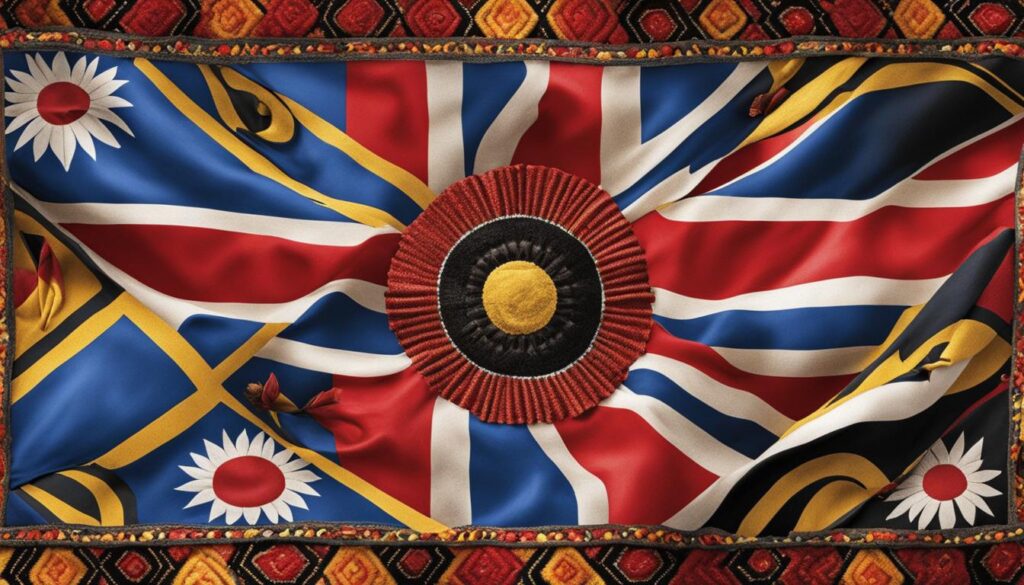
Exhibitions and museums also incorporate the Aboriginal flag to provide visitors with a deeper understanding of Australia’s Indigenous peoples. Through thematic displays and interactive exhibits, the flag helps paint a vivid picture of the resilience, artistry, and profound connection to the land that define Aboriginal culture.
“The Aboriginal flag serves as a powerful educational tool, inviting learners of all ages to engage with Indigenous histories and experiences. It enables us to celebrate the richness and diversity of Australia’s First Nations peoples.” – Indigenous Education Specialist, Emily Wilson
By integrating the Aboriginal flag into curricula and educational initiatives, schools and institutions embrace the significance of Indigenous Australian heritage. This inclusive approach cultivates an environment that instills respect, empathy, and appreciation for Indigenous cultures, fostering a sense of pride and belonging among Indigenous Australians.
Aboriginal Flag in Schools
Schools play a crucial role in nurturing cultural understanding and promoting reconciliation. The presence of the Aboriginal flag within educational settings supports the development of a culturally aware and inclusive community.
Aboriginal flag-centric activities, such as flag-raising ceremonies and artwork creation, provide opportunities for students to actively participate in acknowledging and celebrating Indigenous cultures. These initiatives encourage dialogue, challenge misconceptions, and foster meaningful connections between Indigenous and non-Indigenous students.
Aboriginal Flag in Cultural Programs
Cultural programs and organizations across Australia utilize the Aboriginal flag to honor and promote Indigenous heritage. National celebrations, such as NAIDOC Week, display the flag prominently, highlighting the achievements and resilience of Indigenous Australians. This visibility helps facilitate public engagement, raising awareness and understanding of Indigenous culture, history, and contributions to society.
Furthermore, the Aboriginal flag often takes center stage in cultural festivals, well-attended by diverse communities eager to learn, celebrate, and engage with Indigenous arts, music, dance, and traditions. These events offer a platform for Indigenous artists, performers, and storytellers to share their talents, preserving and showcasing their rich cultural heritage.
| Benefits of Cultural and Educational Use of the Aboriginal Flag |
|---|
| Fosters cultural appreciation and understanding |
| Promotes meaningful dialogue and reconciliation |
| Encourages pride and a sense of belonging among Indigenous Australians |
| Raises awareness of Indigenous cultures, histories, and achievements |
| Develops empathy and respect among students and the wider community |
The Aboriginal Flag and National Celebrations
During national celebrations and events like Australia Day and NAIDOC Week, the Aboriginal flag takes center stage, proudly displayed to honor the unique contributions and resilience of Indigenous Australians. Its prominent presence serves as a powerful reminder of the ongoing journey towards reconciliation and unity.
The Aboriginal flag’s representation at these significant occasions sparks dialogue and understanding among all Australians. It encourages conversations about the shared history and cultural significance of Indigenous Australians, fostering deeper connections and appreciation for their heritage and contributions.

As the festivities unfold, the powerful symbolism of the Aboriginal flag resonates with people from all walks of life. Its vibrant colors and meaningful design ignite a sense of pride and inclusivity, celebrating the rich cultural tapestry that makes Australia diverse and unique.
International Recognition and Visibility of the Aboriginal Flag
The Aboriginal flag has gained international recognition and visibility as a symbol of Indigenous Australia. Its powerful symbolism and representation of Indigenous rights and cultural identity have made it widely recognized and respected worldwide.
“The Aboriginal flag is not only a powerful emblem of Indigenous Australia but also an important symbol of unity, resilience, and self-determination for Indigenous peoples globally.”
The flag’s presence at international events and forums serves as a testament to the global importance of Indigenous issues. It sparks meaningful conversations on Indigenous rights and perspectives, contributing to a more inclusive and equal society.
When displayed alongside other national flags, the Aboriginal flag stands out, representing the unique heritage and contributions of Indigenous Australians. Its vibrant colors and bold design make it easily recognizable, evoking a sense of pride and identity among Indigenous communities.
| Benefits of International Recognition | Impact on Indigenous Peoples |
|---|---|
|
|
The international recognition and visibility of the Aboriginal flag highlight the ongoing struggle for Indigenous rights and the need for greater respect and understanding of Indigenous cultures. It serves as a beacon of hope, unity, and resilience for Indigenous peoples worldwide.
Celebrating the Aboriginal Flag
The celebration of the Aboriginal flag goes beyond its physical display. It represents a celebration of Indigenous culture, heritage, and resilience. It is an opportunity to honor and acknowledge the rich history and contributions of Indigenous Australians to the broader national identity. Celebrating the flag fosters a sense of unity, respect, and inclusivity in Australian society.
Connecting Communities through the Aboriginal Flag
The Aboriginal flag serves as a powerful symbol of unity, bringing together individuals from various backgrounds and communities. Through displaying the flag and participating in celebrations, we can foster a sense of belonging and strengthen the bond between Indigenous and non-Indigenous Australians. The flag’s vibrant colors and meaningful design serve as a visual reminder of the ongoing journey towards reconciliation and respect.
Wide-Spread Recognition and Commemoration
The significance of the Aboriginal flag is not limited to Australia alone. Its recognition and commemoration extend beyond national boundaries, with the flag being prominently displayed at international events, cultural exchanges, and educational institutions worldwide. Such global visibility highlights the importance of Indigenous rights and fosters international dialogue on cultural diversity and inclusivity.
“The Aboriginal flag is a symbol of pride, resilience, and unity. It represents the rich cultural heritage of Indigenous Australians and reminds us all to honor their contributions to our nation.”
Celebrating Indigenous Heritage and Achievements
By celebrating the Aboriginal flag, we pay tribute to the diverse cultures, traditions, and achievements of Indigenous Australians. It presents an opportunity to engage in cultural exchanges, share stories, and learn about the significant contributions of Indigenous individuals and communities to various fields, such as art, music, sports, and environmental stewardship.
Education and Awareness
Celebrating the Aboriginal flag also plays a crucial role in raising awareness and promoting education about Indigenous history and culture. Through workshops, exhibitions, and community events, we can create meaningful opportunities for people to learn and appreciate the traditions, customs, and values that the flag represents.
Aboriginal Flag Celebrations
| Event | Date | Description |
|---|---|---|
| NAIDOC Week | First week of July | A week-long celebration of Aboriginal and Torres Strait Islander cultures, history, and achievements across Australia. |
| Survival Day | 26th January | Commemorates the survival and resilience of Indigenous cultures on the anniversary of Australia Day. |
| Reconciliation Week | 27th May – 3rd June | A week of activities promoting reconciliation between Indigenous and non-Indigenous Australians. |
| National Aborigines and Islanders Day Observance Committee (NAIDOC) Ball | Various dates | An annual formal event celebrating Aboriginal and Torres Strait Islander cultures. |
Conclusion
The Aboriginal flag is more than just a piece of cloth; it is a powerful symbol that represents the rich heritage, diverse identity, and ongoing struggles of Indigenous Australians. Designed by Harold Thomas, a Luritja man from central Australia, the flag’s simple yet impactful design holds deep cultural and political significance.
With its vibrant colors of black, red, and yellow, the Aboriginal flag symbolizes the connection between Aboriginal people and their ancestral land. The black represents the Indigenous Australians, the red symbolizes the earth and their spiritual connection, while the yellow circle represents the sun, which holds great importance in Indigenous culture.
As an official ‘Flag of Australia,’ the Aboriginal flag plays a crucial role in promoting dialogue, understanding, and increased recognition of Indigenous culture and rights. Its visibility at national and international events sparks conversations about the unique contributions and resilience of Indigenous Australians, fostering unity, inclusivity, and respect in our society.
FAQ
What is the Aboriginal flag?
The Aboriginal flag is a significant symbol representing Indigenous Australians and their connection to the land.
What is the meaning behind the Aboriginal flag?
The flag’s black color represents Aboriginal people, the red symbolizes the earth and spiritual connection to the land, and the yellow circle represents the sun.
Who designed the Aboriginal flag?
The Aboriginal flag was designed by artist Harold Thomas, a Luritja man from central Australia.
When was the Aboriginal flag first raised?
The Aboriginal flag was first raised on July 9, 1971, at a land rights rally in Adelaide, South Australia.
Is the Aboriginal flag recognized by the Australian Government?
Yes, in 1995, the Aboriginal flag was recognized by the Australian Government as an official ‘Flag of Australia’.
What is the legal and copyright status of the Aboriginal flag?
The Commonwealth of Australia acquired the copyright of the Aboriginal Flag in January 2022, with Carroll & Richardson-Flagworld Pty Ltd being the exclusive licensed manufacturer. However, the design can be freely reproduced by the public on all other mediums.
Why is the Aboriginal flag culturally significant?
The Aboriginal flag holds immense cultural significance as a symbol of Indigenous Australians’ history, identity, and connection to the land.
Where is the Aboriginal flag displayed?
The Aboriginal flag is displayed at Indigenous organizations, cultural events, and public buildings to represent and honor Aboriginal heritage. It is also flown alongside the Australian national flag at various locations throughout Australia.
How is the Aboriginal flag used in education?
The Aboriginal flag is incorporated into educational materials, exhibitions, and programs to increase awareness and understanding of Indigenous cultures, histories, and achievements.
How is the Aboriginal flag celebrated during national events?
The Aboriginal flag is prominently displayed during national celebrations and events like Australia Day and NAIDOC Week to honor the contributions and resilience of Indigenous Australians.
Is the Aboriginal flag recognized internationally?
Yes, the Aboriginal flag has gained international recognition and visibility as a symbol of Indigenous rights and cultural identity.
How does celebrating the Aboriginal flag foster unity?
Celebrating the Aboriginal flag fosters a sense of unity, respect, and inclusivity in Australian society by honoring and acknowledging the rich history and contributions of Indigenous Australians.
